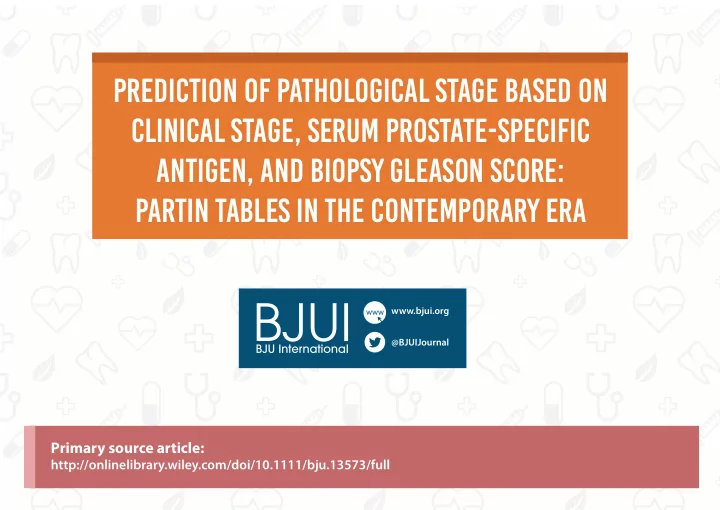

Prediction of pathological stage based on clinical stage, serum prostate-specific antigen, and biopsy Gleason score: Partin Tables in the contemporary era www.bjui.org @BJUIJournal Primary source article: http://onlinelibrary.wiley.com/doi/10.1111/bju.13573/full
OBJECTIVE To update the Partin Tables for prediction of pathological stage in the contemporary setting and examine trends in patients treated with radical prostatectomy (RP) over the past three decades. The Partin Tables remain a straightforward and accurate approach for projecting pathological outcomes based on readily available clinical data. Primary source article: http://onlinelibrary.wiley.com/doi/10.1111/bju.13573/full The ability to accurately predict outcomes after RP using preoperative data remains critical in the counsel- ling and decision-making process of men with prostate cancer.
PATIENTS METHOD Preoperative clinical stage, PSA level, and biopsy underwent RP Gleason score (i.e. prognostic Grade Group - GG) were and pelvic lym- used in a polychotomous logistic regression model to phadenectomy predict the probability of pathological outcomes for histologically categorised as: confirmed prostate cancer January 2010-October 2015, at the Johns Hopkins Hospital. Extraprostatic Organ-confined extension (EPE) (OC) Median (range) age at surgery was: (34-77 years) Lymph node Seminal vesicle involvement involvement Median (range) (LN+) (SV+) serum-prostate specific antigen (PSA) level was: (0.1–125.0) ng/mL Primary source article: http://onlinelibrary.wiley.com/doi/10.1111/bju.13573/full
Proportion of men treated RESULTS with biopsy Gleason score ≤6 cancer (GG1) was: Proportion of men with OC 47% cancer has REMAINED SIMILAR since Observed probabilities outcomes were: 2000, equalling 73-74% overall. OC SV+ in LN+ in disease in EPE in Representing a substantial 4% 2% decrease from the 74% 20% Previous Partin Table results that 63% GS 4+3 and 8 conveyed similar Probability of LN+ Probability of EPE risk for pathologic was INCREASED outcomes were SUBSTANTIALLY in the previous SUBSTANTIALLY confirmed. cohort and HIGHER when biopsy Gleason for biopsy Gleason score increased from 6 score 9-10 (GG5) (GG1) to 3 + 4 (GG2), comparedto lower with smaller increases 77% Gleason scores. for higher grades. in 2000-2005. Primary source article: http://onlinelibrary.wiley.com/doi/10.1111/bju.13573/full
CONCLUSION The proportion of men with OC disease has remained stable since 2000, despite a substantial decline in the proportion of men with biopsy Gleason score 6 (GG1). This is consistent with the notion that many men with Gleason score 6 (GG1) disease were over treated in previous eras. The Partin Tables are available for clinical use via: http://urology.jhu.edu/prostate/ Primary source article: http://onlinelibrary.wiley.com/doi/10.1111/bju.13573/full
Recommend
More recommend